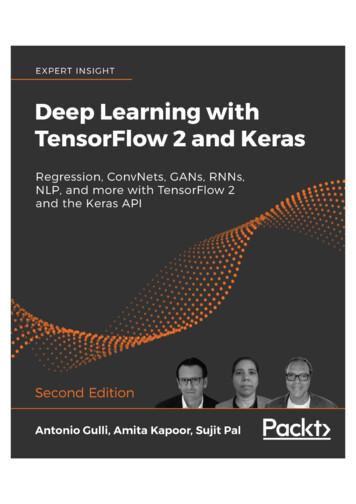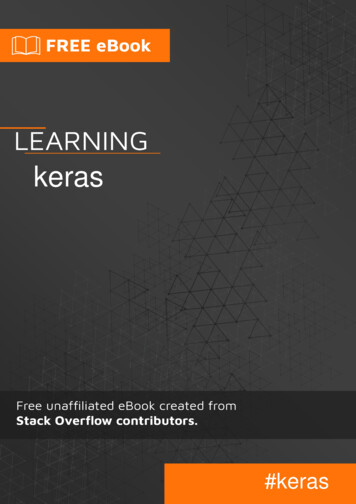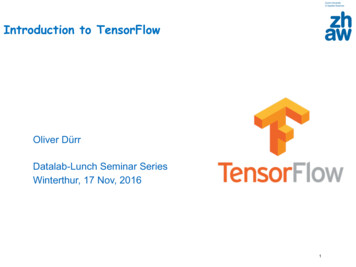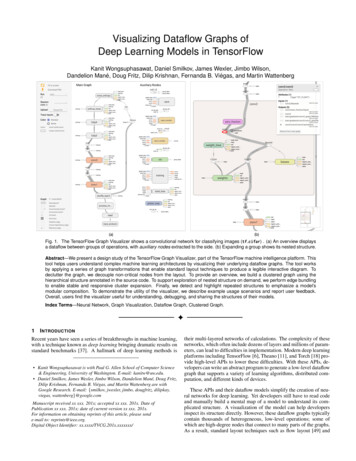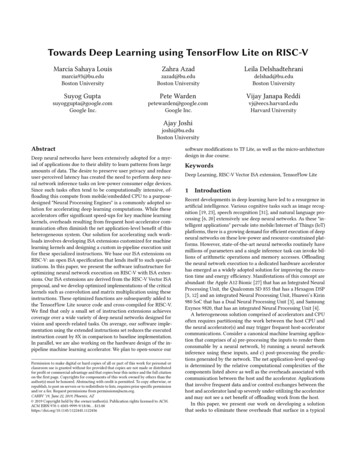
Transcription
Towards Deep Learning using TensorFlow Lite on RISC-VMarcia Sahaya LouisZahra AzadLeila Delshadtehranimarcia93@bu.eduBoston Universityzazad@bu.eduBoston Universitydelshad@bu.eduBoston UniversitySuyog GuptaPete WardenVijay Janapa Reddisuyoggupta@google.comGoogle Inc.petewarden@google.comGoogle Inc.vj@eecs.harvard.eduHarvard UniversityAjay Joshijoshi@bu.eduBoston UniversityAbstractDeep neural networks have been extensively adopted for a myriad of applications due to their ability to learn patterns from largeamounts of data. The desire to preserve user privacy and reduceuser-perceived latency has created the need to perform deep neural network inference tasks on low-power consumer edge devices.Since such tasks often tend to be computationally intensive, offloading this compute from mobile/embedded CPU to a purposedesigned "Neural Processing Engines" is a commonly adopted solution for accelerating deep learning computations. While theseaccelerators offer significant speed-ups for key machine learningkernels, overheads resulting from frequent host-accelerator communication often diminish the net application-level benefit of thisheterogeneous system. Our solution for accelerating such workloads involves developing ISA extensions customized for machinelearning kernels and designing a custom in-pipeline execution unitfor these specialized instructions. We base our ISA extensions onRISC-V: an open ISA specification that lends itself to such specializations. In this paper, we present the software infrastructure foroptimizing neural network execution on RISC-V with ISA extensions. Our ISA extensions are derived from the RISC-V Vector ISAproposal, and we develop optimized implementations of the criticalkernels such as convolution and matrix multiplication using theseinstructions. These optimized functions are subsequently added tothe TensorFlow Lite source code and cross-compiled for RISC-V.We find that only a small set of instruction extensions achievescoverage over a wide variety of deep neural networks designed forvision and speech-related tasks. On average, our software implementation using the extended instructions set reduces the executedinstruction count by 8X in comparison to baseline implementation.In parallel, we are also working on the hardware design of the inpipeline machine learning accelerator. We plan to open-source ourPermission to make digital or hard copies of all or part of this work for personal orclassroom use is granted without fee provided that copies are not made or distributedfor profit or commercial advantage and that copies bear this notice and the full citationon the first page. Copyrights for components of this work owned by others than theauthor(s) must be honored. Abstracting with credit is permitted. To copy otherwise, orrepublish, to post on servers or to redistribute to lists, requires prior specific permissionand/or a fee. Request permissions from permissions@acm.org.CARRV ’19, June 22, 2019, Phoenix, AZ 2019 Copyright held by the owner/author(s). Publication rights licensed to ACM.ACM ISBN 978-1-4503-9999-9/18/06. . . re modifications to TF Lite, as well as the micro-architecturedesign in due course.KeywordsDeep Learning, RISC-V Vector ISA extension, TensorFlow Lite1IntroductionRecent developments in deep learning have led to a resurgence inartificial intelligence. Various cognitive tasks such as image recognition [19, 23], speech recognition [31], and natural language processing [6, 20] extensively use deep neural networks. As these "intelligent applications" pervade into mobile/Internet of Things (IoT)platforms, there is a growing demand for efficient execution of deepneural networks on these low-power and resource-constrained platforms. However, state-of-the-art neural networks routinely havemillions of parameters and a single inference task can invoke billions of arithmetic operations and memory accesses. Offloadingthe neural network execution to a dedicated hardware acceleratorhas emerged as a widely adopted solution for improving the execution time and energy efficiency. Manifestations of this concept areabundant: the Apple A12 Bionic [27] that has an Integrated NeuralProcessing Unit, the Qualcomm SD 855 that has a Hexagon DSP[5, 12] and an integrated Neural Processing Unit, Huawei’s Kirin980 SoC that has a Dual Neural Processing Unit [3], and SamsungExynos 9820, that has an integrated Neural Processing Unit [4].A heterogeneous solution comprised of accelerators and CPUoften requires partitioning the work between the host CPU andthe neural accelerator(s) and may trigger frequent host-acceleratorcommunications. Consider a canonical machine learning application that comprises of a) pre-processing the inputs to render themconsumable by a neural network, b) running a neural networkinference using these inputs, and c) post-processing the predictions generated by the network. The net application-level speed-upis determined by the relative computational complexities of thecomponents listed above as well as the overheads associated withcommunication between the host and the accelerator. Applicationsthat involve frequent data and/or control exchanges between thehost and accelerator land up severely under-utilizing the acceleratorand may not see a net benefit of offloading work from the host.In this paper, we present our work on developing a solutionthat seeks to eliminate these overheads that surface in a typical
CARRV ’19, June 22, 2019, Phoenix, AZLouis et al.Program ExecutionSource CodesIntrinsicsC Source (TFlite)CompilerSpike ISSRISC-VGNU toolchainProgram outputsProcessor supportingRISC-V V ISAFigure 1: Overview of the Software infrastructure. ‘Intrinsics’ are implemented using C inline assembly functions.heterogeneous system. Our solution hinges on developing ISA extensions customized for machine learning kernels and designinga custom in-pipeline execution unit for these specialized instructions. To explore this idea, as a first step, we developed the softwareinfrastructure to support custom domain specific ISA extensionfor machine learning. We used the open source RISC-V ISA as ourtarget ISA [8, 30]. RISC-V ISA consists of a base Integer (I) ISAwhich is mandatory for every RISC-V core implementation, andoptional extensions to the base ISA. The capability of ISA-levelcustomization provides an opportunity to specialize our processordesigns for machine learning workloads.To effectively accelerate ML on RISC-V processors, our ISA extensions are derived from the RISC-V vector ISA proposal [22].We selected a subset of the instructions necessary to implementthe key machine learning kernels. We developed the tool-chainby augmenting the software environment with the right inline assembly support and building the run-time that can effectively mapthe high-level macros to the low-level ISA execution. We addedbasic compiler support for the extended instructions using C inlineassembly functions. The C inline assembly functions are used toimplement TensorFlow Lite [1] kernel operations such as convolution and matrix multiplication. We added these optimized functionsto TensorFlow Lite source code and cross-compiled them for RISCV target. We modified Spike [7], an instruction set simulator, tosupport the extended instructions. Subsequently, we used Spikefor functional verification and for benchmarking machine learningmodels. We use the executed instruction count as the metric tocompare the modified RISC-V ISA with ARM v-8A with NEONAdvanced SIMD extensions [21].2Software EnvironmentWe present our infrastructure for building TensorFlow Lite for RISCV target (Figure 1). As part of the software infrastructure, we haveimplemented a subset of instructions from RISC-V V ISA extension(draft v0.5) [22]. Table 1 shows the list of supported instructions.These instructions are supported using C inline assembly functions.We provide detailed description of modifications to the compilertool-chain, Spike and TensorFlow Lite in the following subsections.2.1Compiler support for ISA extensionsWe use inline assembly functions to enable vector instruction support. The functions are known to the compiler and are mapped toa sequence of one or more assembly instructions. For example, thecode snippet in Listing 1 shows the implementation of the vectorload template function. The function loads an array of elements tothe vector register “va1”. The number of elements to load is configured at run-time by setting two Control Status Register (CSR), i.e.,vcfg and vl as required by the RISC-V V ISA extension.Listing 1: A function to load vector elements.template class T inline void VectorLoadInput(const T* load address) {asm volatile("vls va1, 0(%0), v \t\n": : "r"(load address));}The C inline assembly functions are compiled into assembly codeusing the RISC-V GCC tool-chain. The assembly code is then converted into machine code using GNU assembler (GAS) [11]. GAS isimplemented in two sections, the front-end that handles the parsing of assembly code and the back-end that generates the machinecode. We added support for each of the instructions in Table 1 inthe GAS front-end to parse the extended instructions and check ifthe instruction has a valid opcode and operands. Subsequently, theGAS back-end generates the corresponding machine code for theextended instructions. We then modified the Spike ISA simulatorto verify the functionality of the extended instructions.2.2Instruction simulation support on Spike ISSSpike is a RISC-V Instruction Set Simulator (ISS) [7] and implements a functional model of RISC-V processor. Spike is a functionalsimulator that ignores internal delays such as I/O accesses or memory transactions. Therefore, the simulations are not cycle accurate.Spike executes a user space program using proxy kernel for handling the system calls from a C standard library functions.To support the simulation of the instructions in Table 1, we modified the Spike simulator. We extended the class regfile t withvector registers and macros to read/write values to the registers.In order to load/store data from memory, we extended the classmmu t with macros for loading/storing multiple data from memory.Similar to the scalar pipeline, a memory request is handled by theTLB unit in Spike.We also modified the class processor t to configure the twovector CSRs; vcfg CSR and vl CSR. As specified in RISC-V VectorISA extension [22], the vcfg CSR configures the vector unit by
Towards Deep Learning using TensorFlow Lite on RISC-VCARRV ’19, June 22, 2019, Phoenix, AZTable 1: The subset of RISC-V Vector ISA extension [22] implemented in our software ecosystem.Inst. TypeMemory accessArithmetic InstructionsData MovementInstructionsFunctionvls{b,h,s,d} V Rd , RS 1 , RS 2 , mvlx{b,h,s,d} V Rd , RS 1 , V RS 2 , mLoads a vector into V Rd from memory address in RS 1with unit/const stride in RS 2 or indexed stride in V RS 2vss{b,h,s,d} V RS 3 , RS 1 , RS 2 , mvsx{b,h,s,d} V RS 3 , RS 1 , V RS 2 , mStores a vector in V RS 3 to memory address in RS 1with unit/const stride in RS 2 or with indexed stride in V RS 2vadd V Rd , V RS 1 , V RS 2 , mvmul V Rd , V RS 1 , V RS 2 , mvfadd V Rd , V RS 1 , V RS 2 , mvfmul V Rd , V RS 1 , V RS 2 , mAdd/Multiply values in V RS 1 , V RS 2 and writes to V Rdvmadd V Rd , V RS 1 , V RS 2 , V RS 3 , mvfmadd V Rd , V RS 1 , V RS 2 , V RS 3 , mMultiply values in V RS 1 ,V RS 2 and add V RS 3 , and writes to V Rdvmax V Rd , V RS 1 , V RS 2 , mvmin V Rd , V RS 1 , V RS 2 , mvfmax V Rd , V RS 1 , V RS 2 , mvfmin V Rd , V RS 1 , V RS 2 , mElement-wise maximum/minimum of values in V RS 1 , V RS 2and writes to V Rdvsplat V Rd , V RS 1 , RS 2 , mvbcastx V Rd , RS 1vbcastf V Rd , FRS 1Splats the element in VR1[RS 2 ] to V RdBroadcasts value in RS 1 /FRS 1 to V Rdvredsum V Rd , V RS 1vredmin V Rd , V RS 1vredmax V Rd , V RS 1vfredsum V Rd , V RS 1Reduction of V RS 1 based on sum/max/min,broadcast and store the result to V RdV Rd : Vector destination registersV RS 1, 2, 3 : Vector source registers,m: Two bit encoding for masking; m 00 - scalar shape destination, m 01 - unmasked vector operation, m 10 - mask enabled where v1.LSB 0, m 11 - mask enabled where v1.LSB 1; here v1 is the mask register.setting the highest number of enabled vector registers in vregmaxCSR and the maximum width of elements in vemaxw CSR. Thevl CSR holds the current active vector length. Finally, we addedsupport in Spike for all the instructions in Table 1. Listing 2 isan example of implementation vadd instruction in Spike. Thesemodification enabled simulation of the vector instructions. Weadded functionality to Spike interactive debug mode to facilitatetracing and debugging.Listing 2: Implementation of vadd instruction in Spike.require extension('V');require rv64;WRITE VRD(v add(VRS1, VRS2, EW, insn.m(), VMASK, VL));2.3RISC-V target for TensorFlow LiteTensorFlow Lite is a lightweight deep learning framework for mobile and embedded devices [1]. It compresses a TensorFlow modelto a .tflite model that has a small binary size. This enables on-devicemachine learning and uses hardware acceleration to improve performance. The TensorFlow Lite source code has two implementations; reference ops and optimized ops, for machine learning kernels such as convolution and depthwise-convolution. Thereference ops implementation is portable, hardware-independentand uses standard C/C libraries. The optimized ops is a hardware specific optimized implementation of kernel operations using gemmlowp, Eigen libraries [13, 18] and other processor specific optimizations. For example, in the case of ARM processors,the optimized ops implementation leverages gemmlowp, Eigenlibraries and Neon instructions [21] to optimize kernel operations.To support RISC-V target for Tensorflow Lite, we modified somefunctions to remove library dependencies not supported by Newlib 1[29] in reference ops . This made the reference ops implementation portable and capable of running on mobile and embeddeddevice with RISC-V processors. The C inline assembly functionswere used for constructing SIMD-aware optimized functions to beused in optimized ops implementation for RISC-V vector processors. Listing 3 shows the implementation of a function that performs1Cstandard library implementation intended for use on embedded system
CARRV ’19, June 22, 2019, Phoenix, AZLouis et al.RV-base-v1RV-base-v2ARM-base2.52.01.51.054# Cycles# Committed .50.001111et-2v8) lenet-v8)et-2v8) lenet-v8)nneellbi 1bi 2bi 1bi 2Mo(0.25, Mo (0.5, 1 Mo(0.75, Mo (1.0, 11111et-2v8) lenet-v8)et-2v8) lenet-v8)nneellbi 1bi 2bi 1bi 2Mo(0.25,Mo (0.5, 1 Mo(0.75,Mo (1.0, 1(a)(b)Figure 2: Comparison of committed instructions, cycles and IPC for ARM-base, RV-base-v1 without loop optimization and RVbase-v2 with loop optimization for four variants of MobileNet [14]. Here, Mobilenet-v1 (0.25, 128) means MobileNet-V1 modelfor input size of 128x128 pixels and 0.25 depth multiplier. The depth multiplier changes the number of channels in each layer.element-wise addition of two arrays. Using the instructions in Table1, we can support a wide range of machine learning models.We cross-compiled the TensorFlow Lite source code for RISC-VISA and executed .tflite models on Spike. With the infrastructure inplace, we generate a binary that can run on a RISC-V processor thathas micro-architectural support for the RISC-V V ISA extension.Listing 3: A example function for element-wise addition oftwo arrays.void VectorVectorAdd(const float* input1,const float* input2,float* output, int len) {int new len len - (len & (kMaxVectorLength32 - 1));int len diff len & (kMaxVectorLength32 - 1);SetConfig(kElementWidthMax32, kMaxVectorLength32);for (int i 0; i new len; i kMaxVectorLength32) {VectorLoad((input1 i), (input2 i));VectorAddFloat();VectorStore((output i));}}3if (len diff ! 0) {SetVl(len diff);VectorLoad((input1 new len), (input2 new len));VectorAddFloat();VectorStore((output new len));}EvaluationIn this section, we evaluate the code optimizations for RISC-V andcompare it with ARM processors, as ARM processors are the mostcommonly used processors for mobile systems. For comparisonpurpose we define the Region Of Interest (ROI) as the execution ofinterpreter- Invoke() function in TensorFlow Lite. The deep learningmodels [14–17, 25, 26] used in our evaluation are listed in Table2. These are commonly used machine-learning inference modelsthat are deployed on mobile devices. We cover a wide range ofapplications using these benchmark models. The models are 32bit floating point .tflite models and are hosted on TensorFlow Litewebsite [2].To evaluate the performance of deep learning models listed in Table 2 for ARM processor, we used gem5 [9] in full system mode withARM A-class, 4-stage pipeline High Performance In-order (HPI)core configuration [28]. The ARM HPI was configured with 16KBL1 I , 16KB L1 D and without L2 2 . In this section, we will usethe term ARM-base for the baseline implementation of TensorFlowLite using reference ops, and ARM-opt for the implementation ofTensorFlow Lite using optimized ops. We inserted m5 reset statsand m5 dump stats functions in TensorFlow Lite source code toget gem5 performance stats for ROI. We used number of cycles andcommitted instructions as our performance metrics for evaluation.For RISC-V, RV-base and RV-opt represents the RISC-V crosscompiled binaries of TensorFlow Lite using reference ops andoptimized ops, respectively. We mapped a in-order 5-stage pipelineRocket core [7] to Zedboard [10] to evaluate the performance ofbenchmarks in Table 2 for RV-base. The Rocket core is configuredwith 16KB L1 I , 16KB L1 D and without L2 , as the current version of Rocket chip does not support L2 . We used hardware performance counters, specifically the cycle CSR and instret CSRfor evaluation. Currently, the microarchitecture enhancement toRocket-chip processor for supporting extended instructions in Table 1 is in the ‘pre-pre-alpha stage’. For this paper we use Spiketo benchmark number of committed instructions of deep learningbenchmarks listed in Table 2 for RV-opt.2 Wesimulated ARM core without L2 to perform a fair comparison with RISC-VRocket core
Towards Deep Learning using TensorFlow Lite on RISC-V# Committed InstructionsRV-base-v210CARRV ’19, June 22, 2019, Phoenix, Speech decoder Speech encoderFigure 3: Number of committed instructions for RV-base-v2, ARM-base, RV-opt-v1 optimized with 128bits registers, ARM-optand RV-opt-v2 optimized with 256bit registers for various deep learning models.Table 2: List of deep learning models using in our evaluation. CONV Convolution layer, LSTM Long Short TermMemory.ApplicationModelDominant layerAutoMLImage ClassificationMnasNet variantsDenseNet,Inception V3,ResNet 50,MobileNet variants,Yolo tinySpeech encoder/decoderCONVCONVCONVCONVCONVCONVLSTMObject DetectionSpeech RecognitionARM-base and RV-base are cross-complied from the same sourcecode. Although in both cases, we used “-O3” compiler flag, we noticed that the number of committed instructions and correspondingcycles in ROI were higher for RV-base as compared to ARM-base.Figure 2 shows the number of committed instructions and number of cycles for four variants of MobileNet [14] model used inimage classification workload. Figure 2 show the number of committed instructions and cycles are 2X higher for RV-base-v1 incomparison to ARM-base. Here, RV-base-v1 corresponds to crosscomplied from TensorFlow Lite reference ops. The difference ininstruction and cycle count is due to the difference in the compiler optimizations. As the ARM cross-compiler has matured overthe years, the compiler optimizes a nested loops in source codesuch that the inner-most loop has few instructions. We updatedthe source code to replicate the compiler loop optimizations. Werefer to this updated version as RV-base-v2. As shown in Figure 2aand 2b, the loop optimization reduced the number of committedinstructions and cycles for RV-base-v2, and these numbers are nowcomparable to that of ARM-base. For the rest of our analysis we willuse RV-base-v2 and ARM-base as our baseline implementations.We next compare ARM-opt and RV-opt implementations usingthe number of committed instructions for the deep learning modellisted in Table 2. ARM-opt implements ARM Neon extension [21].ARM Neon extension has a fixed SIMD width of 128bits. The benchmark models use single precision floating point, therefore the processor operates on 4 single floating precision values in one instruction. We set the RISC-V vector register width to be 128bits for afair comparison with ARM processor with Neon extension. Also,we evaluated the setup for vector register width of 256bits. Figure3 shows the comparison of ARM-base, RV-base-v2, ARM-opt andRV-opt-v1 with 128bits register widths and RV-opt-v2 256bits register widths using deep learning models in Table 2. As expected, thenumber of committed instructions are similar (across all the models)for ARM-base and RV-base-v2. On average, across all benchmarksthe number of committed instructions for RV-opt-v1 is 1.25X lowerthan the ARM-opt. In deep learning models where ‘CONV’ are thedominant layers, RV-opt-v1 has consistently less instructions thanARM-opt. In the case of models where LSTM layers are dominant,ARM-opt has consistently less instructions than RV-opt-v1. This isbecause of difference in code optimization for ARM and RISC-V.ARM-opt implementation uses block vector-matrix multiplicationfor LSTM layers. The instruction count for RV-opt-v1 can be improved by implementing block vector-matrix multiplication.On average, we achieved a 8X reduction on number of committed instructions using RV-opt-v1 implementation in comparisonto RV-base. We see an additional 2X reduction in the number ofcommitted instructions using RV-opt with 256bits register width.4Summary and Future WorkIn this paper, we present the software infrastructure we developedto support compilation and execution of machine learning modelsused in TensorFlow Lite framework. We are able to support a largerange of machine learning applications using a subset of RISC-VVector instructions. On average, we are able to reduce the numberof committed instructions by 8X using RV-opt implementation incomparison to the RISC-V reference implementation.In our current software pipeline, we handle register namingand register allocations. Moving forward we want the compiler tohandle this task. To enable the compiler to do this task, we needto support the new instructions in GCC using intrinsics. The GCCcompiler has three stages, the front-end, middle-end and back-end[24]. At a high level, the front-end generates a parse-tree from theinput program, the parse-tree is used by middle-end to generate ageneric-tree, and the back-end converts the generic-tree to assembly
CARRV ’19, June 22, 2019, Phoenix, AZcode. As part of the future work, we will modify the front-end toinclude the specification of the intrinsics in GCC source code. Wewill also modify the back-end of GCC to create machine descriptionof the new instructions and generate the assembly code.We are developing in-pipeline microarchitectural support for asubset of the vector instructions for machine learning accelerator.Our microarchitecture will include dedicated vector registers, vector caches and support for multiple precision arithmetic and logicaloperations. Additionally, we will explore sparsity-aware microarchitecture design for the in-pipeline accelerator. As we develop thein-pipeline accelerator we will modify the subset of instructions inTable 1 as needed and update the software tool-chain accordingly.We will evaluate our design in terms of performance, power andarea. We will open source our software modifications to TF Lite, aswell as the micro-architecture design to the wider community indue course.References[1] 2017. TensorFlow Lite TensorFlow. https://www.tensorflow.org/lite[2] 2018. Hosted models TensorFlow Lite TensorFlow. https://www.tensorflow.org/lite/guide/hosted models[3] 2018. Huawei Kirin 980. 4] 2019. Exynos 9 Series 9820 Processor. [5] 2019. Snapdragon 855 Mobile Platform. obile-platform[6] Ahmad Abdulkader, A Lakshmiratan, and J Zhang. 2016. Introducing DeepText:Facebook’s text understanding engine. Facebook Code (2016).[7] Krste Asanovic, Rimas Avizienis, Jonathan Bachrach, Scott Beamer, David Biancolin, Christopher Celio, Henry Cook, Daniel Dabbelt, John Hauser, Adam Izraelevitz, et al. 2016. The rocket chip generator. EECS Department, University ofCalifornia, Berkeley, Tech. Rep. UCB/EECS-2016-17 (2016).[8] Krste Asanović and David A Patterson. 2014. Instruction sets should be free: Thecase for risc-v. EECS Department, University of California, Berkeley, Tech. Rep.UCB/EECS-2014-146 (2014).[9] Nathan Binkert, Bradford Beckmann, Gabriel Black, Steven K Reinhardt, AliSaidi, Arkaprava Basu, Joel Hestness, Derek R Hower, Tushar Krishna, SomayehSardashti, et al. 2011. The gem5 simulator. ACM SIGARCH Computer ArchitectureNews 39, 2 (2011), 1–7.[10] Louise H Crockett, Ross A Elliot, and Martin A Enderwitz. 2015. The zynq booktutorials for zybo and zedboard. Strathclyde Academic Media.[11] Dean Elsner, Jay Fenlason, et al. 2000. Using as: the GNU Assembler. IUniverseCom.Louis et al.[12] Andrei Frumusanu. 2018. The Qualcomm Snapdragon 855 Pre-Dive: Going IntoDetail on 2019’s Flagship Android SoC. 5-going-into-detail/2[13] Gaël Guennebaud, Benoît Jacob, et al. 2010. Eigen v3. http://eigen.tuxfamily.org.[14] Andrew G Howard, Menglong Zhu, Bo Chen, Dmitry Kalenichenko, WeijunWang, Tobias Weyand, Marco Andreetto, and Hartwig Adam. 2017. Mobilenets:Efficient convolutional neural networks for mobile vision applications. arXivpreprint arXiv:1704.04861 (2017).[15] Gao Huang, Zhuang Liu, Laurens Van Der Maaten, and Kilian Q Weinberger.2017. Densely connected convolutional networks. In Proceedings of the IEEEconference on computer vision and pattern recognition. 4700–4708.[16] Rachel Huang, Jonathan Pedoeem, and Cuixian Chen. 2018. YOLO-LITE: A RealTime Object Detection Algorithm Optimized for Non-GPU Computers. In 2018IEEE International Conference on Big Data (Big Data). IEEE, 2503–2510.[17] Forrest N Iandola, Song Han, Matthew W Moskewicz, Khalid Ashraf, William JDally, and Kurt Keutzer. 2016. SqueezeNet: AlexNet-level accuracy with 50xfewer parameters and 0.5 MB model size. arXiv preprint arXiv:1602.07360 (2016).[18] Benoit Jacob and Pete Warden. 2017. gemmlowp: a small self-contained lowprecision GEMM library.[19] Yann LeCun, Yoshua Bengio, and Geoffrey Hinton. 2015. Deep learning. nature521, 7553 (2015), 436.[20] William D Lewis. 2015. Skype translator: Breaking down language and hearingbarriers. Translating and the Computer (TC37) 10 (2015), 125–149.[21] Venu Gopal Reddy. 2008. Neon technology introduction. ARM Corporation 4(2008), 1.[22] Riscv. 2019. riscv/riscv-v-spec. https://github.com/riscv/riscv-v-spec[23] Jürgen Schmidhuber. 2015. Deep learning in neural networks: An overview.Neural networks 61 (2015), 85–117.[24] Richard M Stallman. 2002. GNU compiler collection internals. Free SoftwareFoundation (2002).[25] Christian Szegedy, Vincent Vanhoucke, Sergey Ioffe, Jon Shlens, and ZbigniewWojna. 2016. Rethinking the inception architecture for computer vision. InProceedings of the IEEE conference on computer vision and pattern recognition.2818–2826.[26] Mingxing Tan, Bo Chen, Ruoming Pang, Vijay Vasudevan, and Quoc V Le. 2018.Mnasnet: Platform-aware neural architecture search for mobile. arXiv preprintarXiv:1807.11626 (2018).Apple iPhone Xs Max Teardown.[27] Techinsights.com. ts/overview/blog/apple-iphone-xs-teardown/[28] Ashkan Tousi and Chuan Zhu. 2017. Arm Research Starter Kit: System Modelingusing gem5. (2017).[29] Corinna Vinschen and Jeff Johnston. 2013. Newlib.[30] Andrew Waterman, Yunsup Lee, David Patterson, and Krste Asanovic. 2014. TheRISC-V instruction set manual. volume I: User-level ISA, version 2.0, EECS Department, University of California, Berkeley, Tech. Rep. UCB/EECS-2014-54 (2014).[31] Yonghui Wu, Mike Schuster, Zhifeng Chen, Quoc V Le, Mohammad Norouzi,Wolfgang Macherey, Maxim Krikun, Yuan Cao, Qin Gao, Klaus Macherey, et al.2016. Google’s neural machine translation system: Bridging the gap betweenhuman and machine translation. arXiv preprint arXiv:1609.08144 (2016).
Towards Deep Learning using TensorFlow Lite on RISC-V CARRV ’19, June 22, 2019, Phoenix, AZ Table 1: The subset of RISC-V Vector ISA extension [22] implemented in our software ecosystem. Inst. Type Instructions Function Memory access vls{b,h,s,d} VRd, RS 1, RS2, m vlx{b,h,s,d} VRd, RS1, V



